Connecting...

This is a quick preview of the lesson. For full access, please Log In or Sign up.
For more information, please see full course syllabus of AP Physics 1 & 2
For more information, please see full course syllabus of AP Physics 1 & 2
AP Physics 1 & 2 Electric Fields & Forces
Lecture Description
Electricity is another large topic in physics. To begin, you’ll learn what objects you’ll be dealing with. Rather than a box on a plane, we’ll be talking about an electron in space for most problems. Electrons have special properties about them that allow them to constantly exert a force that will only be felt by other electrons or protons. This force is derived from Coulomb’s law, and is the reason why negative and positive charges attract. We call the field of the force a particle exerting on its own an electric field. These are the basics of electricity, and will carry you on into more advanced subjects.
Bookmark & Share
Embed
Share this knowledge with your friends!
Copy & Paste this embed code into your website’s HTML
Please ensure that your website editor is in text mode when you paste the code.(In Wordpress, the mode button is on the top right corner.)
×
Since this lesson is not free, only the preview will appear on your website.
- - Allow users to view the embedded video in full-size.
Next Lecture
Previous Lecture










































 Answer Engine
Answer Engine


1 answer
Mon Feb 29, 2016 10:23 AM
Post by Sarmad Khokhar on February 29, 2016
In 6:02 how did you figured out that there would be positive charge ?
1 answer
Mon Feb 29, 2016 10:13 AM
Post by Sarmad Khokhar on February 29, 2016
Do we need to know questions that involve vector addition for coulomb's law in AP Physics 2 course ?
1 answer
Sun Feb 7, 2016 11:31 AM
Post by Gabrielle Martinez on February 6, 2016
I wonder why I can't find the " Electric Field Due to a Line of Charge" section. I've attempted to search online on various sites for explanations and have not been successful.
1 answer
Mon Nov 23, 2015 7:17 AM
Post by Parth Shorey on November 16, 2015
Is the Q&A active?
1 answer
Sat Aug 15, 2015 2:35 PM
Post by Anh Dang on August 13, 2015
In example 5, so if it was repulsion instead, would the electrostatic force be negative?
1 answer
Thu Aug 13, 2015 5:24 PM
Post by Anh Dang on August 13, 2015
For the electroscope, why is it that when you touch the knob with a negative charge rod, you get a negative charge at the bottom of the leaves and the positive charge at the knob part? Where did the positive charges come from?
And why , if reversed, when you put a positive charged rod to the knob, the whole metal part is positive without a negative charge at the knob?
1 answer
Sun Apr 12, 2015 4:49 PM
Post by Geoffrey Miller on April 12, 2015
Great lecture, Professor Fullerton. I have a question regarding example 5. Why is the answer positive and not negative 6.9*10^6? Is it because the force is a scaler in this instance?
2 answers
Last reply by: Hassan BIn Mazhar
Sat Oct 25, 2014 1:30 AM
Post by Hassan BIn Mazhar on October 23, 2014
Hello sir,I would like to ask u a question:If human body is a conductor and Earth is an infinite source of charge then would we have an electrostatic attraction from Earth as well?
1 answer
Sun May 25, 2014 11:05 AM
Post by Matej Neumann on May 25, 2014
Could the example 8 also be solved by using vectors? with the equation
E=k*q*r/r^3 and then adding all the j and i components together?
0 answers
Post by Madina Abdullah on May 5, 2014
Thank you Sir
1 answer
Sat Sep 7, 2013 5:48 PM
Post by Sam Mukau on September 7, 2013
for example 7, does the distance between the plates not matter? you did not use it in the calculation
1 answer
Sat Aug 31, 2013 12:50 PM
Post by Jude Nawlo on August 31, 2013
Also, in example 9, since both of the points are positive charges, why do they move in a direction towards each other if we know that like charges repel each other?
1 answer
Sat Aug 31, 2013 9:11 AM
Post by Jude Nawlo on August 31, 2013
For Example 3, I understand that the two conductors will distribute their charges equally, which result in both of them having four elementary charges. I understand the mathematical procedure of multiplying by 1.6 x 10^19 to get the charge of each. But I am confused about signs. If we are denoting the elementary charge as "e," then isn't that referring to an electron, and if so, why isn't the final charge of each conductor negative (since electrons are negative?)Or does the elementary charge refer to a positive or negative state or charge?
1 answer
Fri May 3, 2013 6:21 AM
Post by help me on May 2, 2013
Wonderful videos :) Thank you very much for starting your own Educator course. Very helpful, indeed.